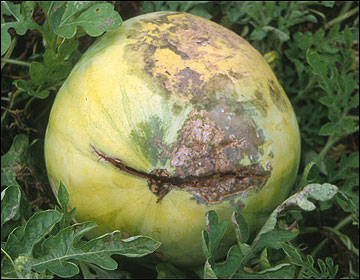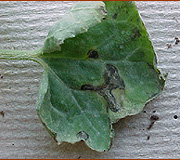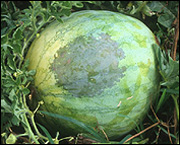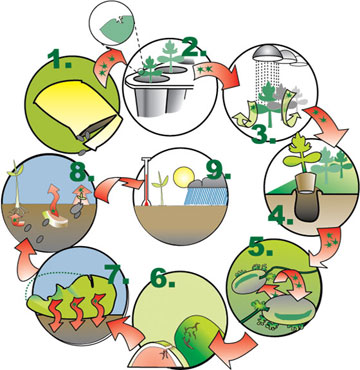Bacterial fruit blotch (BFB) is a serious disease infecting watermelons. The causal organism, Acidovorax avenae subsp. citrulli, was first identified in the United States in 1989 and in Missouri in 1994. This pathogen can cause significant yield losses depending on the stage of growth in which it infects the crop. Infections that develop early can destroy up to 100 percent of the marketable watermelon crop.
 Bacterial fruit blotch infection spreads rapidly, causing rupture of the rind and subsequent fruit rot.
Bacterial fruit blotch infection spreads rapidly, causing rupture of the rind and subsequent fruit rot.
Symptoms
Symptoms of BFB can be observed on the seedling transplants, mature leaves and fruit.
Seedling transplants
Water-soaked, "oily" areas on the underside of the cotyledons or seedling leaves often paralleling the veins with a yellow halo are characteristic symptoms. The infected areas dry up and become elongated, angled, black, necrotic patches. Some seedlings will collapse and die immediately from infection (Figure 1). Others can retain the bacterial infection and will not exhibit symptoms until fruit set.

 Figure 1
Figure 1
Acidovorax avenae lesions appear as dark, angular patches on watermelon seedling transplants.
Leaves
Because the vines do not drop their leaves when infected with A. avenae, the lesions are difficult to see. The lesions tend to be small, dark, and angled. Leaf lesions are significant reservoirs of bacteria for fruit infection. Leaf lesions will usually be observed at temperatures above 90 degrees Fahrenheit. Stems, petioles and roots are not infected, and thus do not show symptoms.
Fruit
Bacteria from leaf lesions can spread and infect developing fruit. Infection of fruit occurs at flowering and early fruit set. Two- to three-week-old developing fruit that has not formed a wax layer is most susceptible to A. avenae infection. Once the fruit matures and develops a wax layer, it is more difficult for the bacteria to invade the fruit. The diagnostic symptom of BFB is a dark green stain or blotch on the upper surface of the developing fruit. The blotch may be 0.5 inch in diameter at first, but will rapidly expand to cover the entire fruit surface within a week if environmental conditions are favorable (Figure 2). The bacteria infection does not extend into the meat of the melon, but will cause the rind to rupture, enabling infection by secondary pathogens that cause the fruit to rot.

 Figure 2
Figure 2
Bacterial fruit blotch infection on mature watermelon fruit appears first as a small, dark green stain on the upper surface, left. Initially the infection does not extend past the rind.
Disease cycle
Figure 3
The disease cycle for bacterial fruit blotch.
 A pathogen is introduced with a contaminated watermelon seed.
A pathogen is introduced with a contaminated watermelon seed.- Contaminated seed results in infected seedlings with characteristic lesions on cotyledons.
- Overhead irrigation disperses the pathogen throughout transplant facilities. A few infected seedlings threaten all others.
- Infected seedlings with inconspicuous lesions are transplanted to the field.
- Bacteria spread to neighboring plants in the field. Fruit can be infected at an early age.
- Lesions on watermelons become apparent shortly before the fruit ripens.
- Diseased fruit decays in the field. Seeds from diseased fruit slip into the soil.
- Local sources of inoculum: volunteer seedlings from seeds of infected fruit, buried infested rind, cucurbit weed hosts.
- Environmental factors detirmine how serious a threat is posed to subsequent crops by bacteria that survive in volunteers, rinds and weeds.
The cycle for bacterial fruit blotch infection normally begins with contaminated seed (Figure 3). In Missouri, the majority of watermelon acreage is field established by transplants. The infected seed is sown in the greenhouse in soilless potting media and plastic trays. The greenhouse is an excellent environment for spread of BFB. High temperatures and humidity are requisites for development of BFB. Many transplant production greenhouses top-water transplants, which aids in splash dispersal of the pathogen to other plants. Bottom watering of transplants will help control BFB. Movement of infected plants from the greenhouse to the field can have serious consequences. Once in the field, high temperature, humidity and wet weather favor spread of the disease. Diseased fruit decays and infected seeds and cucurbit weeds (e.g., citron) are hosts for the BFB pathogen. Bacterial fruit blotch cannot survive for more than a few weeks during the summer without a plant host.
At present, there is no complete varietal resistance to BFB. However, some watermelon cultivars are more susceptible to BFB than others. Cultivars with dark green rinds are less susceptible to BFB than light green-rind cultivars. Triploid seedless watermelons are less susceptible to BFB than seeded diploid melons. Seedless melons can sustain high levels of leaf infection with low levels of fruit infection.
However, seed treatments used to reduce bacterial contamination of watermelon seeds can inhibit germination of triploid seedless melons. Bacterial fruit blotch has been reported to infect cantaloupe and tomato, but the preferred host is watermelon.
Disease management
Management of bacterial fruit blotch entails the following steps:
- Practice good greenhouse sanitation:
- Use a 10 percent bleach solution or Physan 20 to dip all tools, recycled planting trays, and containers for at least 10 minutes.
- Spray benches and the interior with the same solution.
- Remove any weeds growing in the greenhouse.
- Water plants evenly in early morning or by afternoon.
- Purchase watermelon seed that has been tested negative for bacterial fruit blotch in a seedling grow-out test.
- Monitor transplants for symptoms.
- Try to segregate triploid seedless varieties and seed lots from diploid seeded varieties in the greenhouse.
- Reduce physical contact with the seedlings.
- .If suspicious symptoms are observed, remove infected plants and have them diagnosed immediately for bacterial fruit blotch. Contact MU Extension and your regional horticulture specialist, who will have the plants assayed for BFB. Proper identification of BFB is essential, because other less harmful bacteria can produce identical symptoms on seedling plants.
- If transplants are confirmed to have BFB, destroy all transplants from that seed lot. Transplants from other varieties in the same house should not be planted in the field.
- A greenhouse with infected transplants can be decontaminated (Step 1) and planted the following season.
- If infected plants or potentially infected plants have been transplanted in the field, begin copper spray applications to suppress BFB (Table 1). Copper hydroxide fungicides can be tank mixed with most fungicides used to control fungal diseases. If symptoms are observed, copper hydroxide should be applied immediately after planting on a 7- to 10-day schedule. If no symptoms are observed but BFB is suspected, copper hydroxide should be applied when the first male flowers appear. Continue spray applications until all fruit have reached maturity. Fields should not be cultivated or sprayed when the foliage is wet. Follow all label recommendations for any pesticide application.
- If BFB has occurred, follow a strict three-year rotation, deep plow after harvest and control all volunteer melons and cucurbit weeds.
Table 1. Pesticides labeled for suppression of bacterial fruit blotch.
| Trade name | Common name | Rate per acre | Comments |
|---|---|---|---|
| Kocide 2000 | Copper hydroxide (54 percent) | 1.5 pounds | |
| Kocide 4.5 LF | Copper hydroxide (38 percent) | 1.33 pints | |
| Kocide DF | Copper hydroxide (61 percent) | 2 pounds | 5-day postharvest intverval; Apply at 14-day intervals. |
| ManKocide DF | Copper hydoxide (46 percent) + Mancozeb | 2.5 pounds | 5-day postharvest interval; Apply at 14-day intervals. pH of spray solution must be above 6.5. |
| Nu-Cop 50 DF | Copper hydroxide (77 percent) | 2 pounds | |
| Nu-Cop 3L | Copper hydroxide (38 percent) | 1-4 pints |
Publications
- Egel, D. 2001. Bacterial fruit blotch. In: Vegetable Crops Hotline. Purdue University Cooperative Extension Service
- Hopkins, D. 1996. Blocking fruit blotch. The Grower 29(8): 9-10
- Hopkins, D., and R. X.Latin. 2001. Diseases. In: Watermelons, Characteristics, Production, and Marketing (D. Maynard, editor). Alexandria, Va.: American Society for Horticultural Science Press
- Isakeit, T. 1999. Bacterial fruit blotch of watermelon. Texas Agricultural Extension Service Publication L-5222
- Latin, R. X. 1993. Diseases and pests of muskmelons and watermelons. Purdue University Cooperative Extension Service Publication BP-44
Technical assistance
- MU Plant Diagnostic Clinic
http://plantclinic.missouri.edu/ - State Entomologist
Plant Industries Division
Missouri Department of Agriculture
P.O. Box 630
Jefferson City, Mo. 65102
573-751-5507